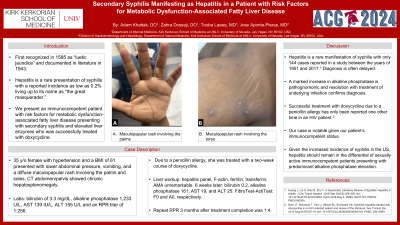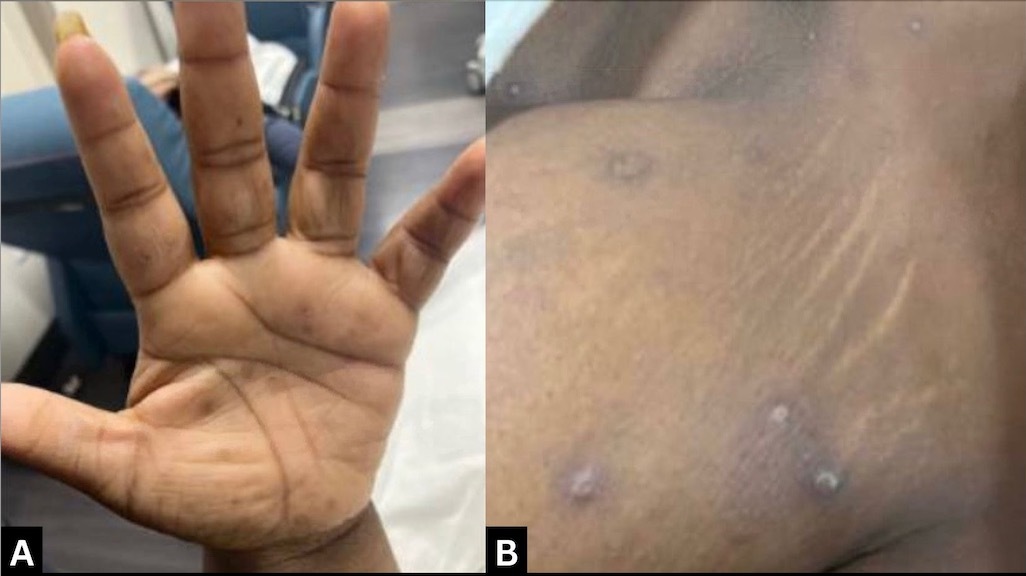Tuesday Poster Session
Category: Liver
P4851 - Secondary Syphilis Manifesting as Hepatitis in a Patient With Risk Factors for Metabolic Dysfunction-Associated Fatty Liver Disease
Tuesday, October 29, 2024
10:30 AM - 4:00 PM ET
Location: Exhibit Hall E

Has Audio

Adam Khattak, DO
Kirk Kerkorian School of Medicine at the University of Nevada
Las Vegas, NV
Presenting Author(s)
Adam Khattak, DO, Zahra Dossaji, DO, Tooba Laeeq, MD, Jose Aponte-Pieras, MD
Kirk Kerkorian School of Medicine at the University of Nevada, Las Vegas, NV
Introduction: First recognized in 1585 as “luetic jaundice” and documented in literature in 1943, hepatitis is a rare presentation of syphilis with a reported incidence as low as 0.2% living up to its name as “the great masquerader.” We present an immunocompetent patient with risk factors for metabolic dysfunction-associated fatty liver disease presenting with secondary syphilis and elevated liver enzymes who was successfully treated with doxycycline.
Case Description/Methods: A 35-year-old female with hypertension and a BMI of 61 presented to the emergency department with lower abdominal pressure, vomiting, and a diffuse maculopapular rash involving the palms and soles. CT abdomen and pelvis showed stable chronic hepatosplenomegaly. Labs revealed a bilirubin of 3.3 mg/dL, alkaline phosphatase 1,233 U/L, AST 139 IU/L, ALT 155 U/L and an RPR titer of 1:256. Due to a history of penicillin allergy causing vaginal edema she was discharged with a two-week course of doxycycline.
On follow-up, liver workup with a hepatitis panel, F-actin, ferritin, transferrin, AMA were unremarkable. Liver enzymes were repeated 6 weeks later showing bilirubin 0.2 mg/dL, alkaline phosphatase 161 U/L, AST 19 U/L, and ALT 25 U/L. An ultrasound elastography was not performed due to concern for reliability given the patient’s body habitus. A FibroTest-ActiTest revealed scores of F0 and A0, respectively. Repeat RPR 3 months after treatment completion was 1:4.
Discussion: Hepatitis is a rare manifestation of syphilis with only 144 cases reported in a study between the years of 1951 and 2017. Diagnosis of this benign condition is often delayed, particularly when underlying metabolic risk factors are present, as seen with our patient. A marked increase in alkaline phosphatase is pathognomonic and resolution with treatment of the underlying infection confirms the diagnosis according to the diagnostic criteria established in 2004 by Mullick et al.
Successful treatment with doxycycline due to a penicillin allergy has only been reported in the literature one other time, and that was in an HIV patient. This suggests that doxycycline may be an effective therapy for syphilitic hepatitis, however, further studies are warranted. Our case was also notable given our patient’s immunocompetent status. Given the increased incidence of syphilis in the US in the past decade, hepatitis should remain in the differential of sexually active immunocompetent patients presenting with predominant alkaline phosphatase elevation.

Disclosures:
Adam Khattak, DO, Zahra Dossaji, DO, Tooba Laeeq, MD, Jose Aponte-Pieras, MD. P4851 - Secondary Syphilis Manifesting as Hepatitis in a Patient With Risk Factors for Metabolic Dysfunction-Associated Fatty Liver Disease, ACG 2024 Annual Scientific Meeting Abstracts. Philadelphia, PA: American College of Gastroenterology.
Kirk Kerkorian School of Medicine at the University of Nevada, Las Vegas, NV
Introduction: First recognized in 1585 as “luetic jaundice” and documented in literature in 1943, hepatitis is a rare presentation of syphilis with a reported incidence as low as 0.2% living up to its name as “the great masquerader.” We present an immunocompetent patient with risk factors for metabolic dysfunction-associated fatty liver disease presenting with secondary syphilis and elevated liver enzymes who was successfully treated with doxycycline.
Case Description/Methods: A 35-year-old female with hypertension and a BMI of 61 presented to the emergency department with lower abdominal pressure, vomiting, and a diffuse maculopapular rash involving the palms and soles. CT abdomen and pelvis showed stable chronic hepatosplenomegaly. Labs revealed a bilirubin of 3.3 mg/dL, alkaline phosphatase 1,233 U/L, AST 139 IU/L, ALT 155 U/L and an RPR titer of 1:256. Due to a history of penicillin allergy causing vaginal edema she was discharged with a two-week course of doxycycline.
On follow-up, liver workup with a hepatitis panel, F-actin, ferritin, transferrin, AMA were unremarkable. Liver enzymes were repeated 6 weeks later showing bilirubin 0.2 mg/dL, alkaline phosphatase 161 U/L, AST 19 U/L, and ALT 25 U/L. An ultrasound elastography was not performed due to concern for reliability given the patient’s body habitus. A FibroTest-ActiTest revealed scores of F0 and A0, respectively. Repeat RPR 3 months after treatment completion was 1:4.
Discussion: Hepatitis is a rare manifestation of syphilis with only 144 cases reported in a study between the years of 1951 and 2017. Diagnosis of this benign condition is often delayed, particularly when underlying metabolic risk factors are present, as seen with our patient. A marked increase in alkaline phosphatase is pathognomonic and resolution with treatment of the underlying infection confirms the diagnosis according to the diagnostic criteria established in 2004 by Mullick et al.
Successful treatment with doxycycline due to a penicillin allergy has only been reported in the literature one other time, and that was in an HIV patient. This suggests that doxycycline may be an effective therapy for syphilitic hepatitis, however, further studies are warranted. Our case was also notable given our patient’s immunocompetent status. Given the increased incidence of syphilis in the US in the past decade, hepatitis should remain in the differential of sexually active immunocompetent patients presenting with predominant alkaline phosphatase elevation.

Figure: A- Maculopapular rash involving the palms; B- Maculopapular rash involving the torso
Disclosures:
Adam Khattak indicated no relevant financial relationships.
Zahra Dossaji indicated no relevant financial relationships.
Tooba Laeeq indicated no relevant financial relationships.
Jose Aponte-Pieras indicated no relevant financial relationships.
Adam Khattak, DO, Zahra Dossaji, DO, Tooba Laeeq, MD, Jose Aponte-Pieras, MD. P4851 - Secondary Syphilis Manifesting as Hepatitis in a Patient With Risk Factors for Metabolic Dysfunction-Associated Fatty Liver Disease, ACG 2024 Annual Scientific Meeting Abstracts. Philadelphia, PA: American College of Gastroenterology.

